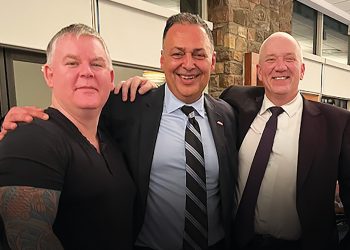RISMEDIA, July 20, 2010—If your organization is like so many others, it seems to have all the ingredients for success firmly in place—a well-thought-out vision, a realistic strategy, skilled, highly-engaged employees, quality products and services and strong customer relationships. So why, in the face of everything you’re doing right, can’t you deliver consistent results? Rick Lepsinger sums up the answer with a concept he’s been studying for years: the execution gap.
“If an organization can’t execute, nothing else matters—not the smartest strategy, not the most innovative business model, not even game-changing technology,” observes Lepsinger, president of OnPoint Consulting and author of Closing the Execution Gap: How Great Leaders and Their Companies Get Results. “And for many companies, there is a clear gap between intent and execution.”
Lepsinger’s research uncovered five characteristics and competencies, which he refers to as “The Five Bridges,” that enable people to traverse the execution gap. It is these bridges that differentiate the companies that are consistently able to get things done from those that aren’t.
Bridge 1: The Ability to Manage Change
Change is inevitable. We all know that. However, despite their sincerest efforts, many companies can’t seem to operationalize that knowledge and turn it into positive action—and that’s a dangerous shortcoming. Simply put, you can’t run a successful business if you can’t adjust to changes in the marketplace.
A Gap Maker: Dell. Just as people can get stuck in a rut, so can businesses. Dell developed “the Dell Way,” and its reluctance to tread off of the beaten path cost it its customers. The company was able to attract customers to its website with low-cost offers that required the buyer to make additions in order to have the best computer (which meant the price would end up being more than the original low-cost offer). But when tons of affordable computers with all the bells and whistles that consumers wanted became readily available through other online outlets and retail stores, consumers didn’t have to go to Dell to get a “custom-made” computer.
Here’s where Dell turned a problem into a huge problem. When its leaders realized they were losing business to competitors, they fell back on a practice that had always worked for them before: they cut costs to maintain market share. One area that suffered was customer service, which had originally been one of the company’s biggest strengths.
Bridge 2: A Structure That Supports Execution
Simply put, successful organizations strike the right balance between centralization and decentralization. Many companies go to great lengths to develop an exciting vision, create a realistic strategy and get employees engaged. But then they just assume the current organizational structure and systems will support the new strategy. Often, it’s just not true.
And structure isn’t just about efficiency, says Lepsinger. A good one enhances accountability, coordination and communication. Plus, it ensures that decisions are being made as close to the action as possible. These are all key components of getting things done.
A Gap Closer: Hewlett-Packard. When Mark Hurd became CEO of Hewlett-Packard, he was constantly asked if he thought acquiring Compaq was a good idea. His answer? The question is irrelevant. Basically, Hurd said what’s done is done, and his job now was to find a way to make it work. He did just that when he reorganized the company into three divisions, each with its own sales force (with the heads of the divisions responsible for sales). He also reorganized the IT function. Instead of having 85 data centers, he centralized them into three.
Bridge 3: Employee Involvement in Decision Making
Admittedly, this is a controversial notion. Some leaders view involving employees in decision making as a sign of weakness. Others fear giving up control. In reality, though, the world is too complex for any leader to go it alone. To make good decisions, you must seek out the perspectives of a wide range of people—and who knows better than employees what the closest-to-the-ground issues are?
A Gap Maker: The NBA. When the National Basketball Association (NBA) tried to introduce a new basketball, guess who they forgot to involve in the decision: the players. That’s right. The NBA came up with a new ball design and never once asked the players how they liked it while it was in development. There’s no reasonable explanation for this faux pas. Asking the players would have increased the quality of the ball itself and the acceptance of the “new ball” decision. Instead, the NBA ended up with a ball that players refused to use because they felt it was difficult to handle when it was damp and it would actually cut their fingers. Because of the player backlash, the NBA had to scrap its “improved” model and go back to the ball the players preferred—the one they have been using for decades.
Bridge 4: Alignment Between Leader Actions, Company Values and Priorities
No company should ever have two sets of values and expectations: one for the leader(s) and one for the employees. When leaders say one thing and do another, business suffers. Of course, we all know that leader behavior is relevant. Still, it might surprise you to learn exactly how much execution depends on how consistent your behavior is with organizational values and priorities.
One, if you’re a leader, employees pattern their behavior after yours. Two, if how you behave signifies that “we are all in this together,” people are more likely to be motivated and go the proverbial extra mile. When you expect employees to behave a certain way or ask employees to focus on certain priorities, you’d better do the same.
Gap Makers: TARP Bailout-Seeking Auto Executives. The CEOs of General Motors, Ford and Chrysler shocked members of Congress and the American people when they used private jets to travel to Washington, D.C. for a hearing. After all, the purpose of the trip was to ask for government assistance to help their companies get through the worst recession in U.S. history and the worst market for car sales in the history of their industry.
Bridge 5: Company-wide Coordination and Cooperation
Most employees have good intentions. They want to cooperate with colleagues and coworkers. Yet, ensuring that decisions and actions are coordinated across organizational boundaries requires more than faith and words alone. It takes shared goals, clear communication and well-defined roles.
A Gap Maker: Toyota. Many people were surprised when Toyota, a brand known for its quality and reliability, recalled over six million cars due to a faulty accelerator pedal. How did this once mighty brand end up with such a PR disaster on its hands?
Toyota used to work with one supplier for each part, explains Lepsinger. But when a fire at a supplier’s facility caused twenty plants to shut down for five days, the company decided it needed a second source as a back-up. For the accelerator, Toyota failed to ensure the parts it was receiving from the two suppliers were identical.
These five execution bridges are critical, says Lepsinger. Without them, you’ll have a tough time achieving your company’s goals. The more bridges you have in place, the more likely you are to do so—and the lack of any one of them could potentially derail your efforts.
About the Author
Richard Lepsinger is president of OnPoint Consulting and has a 25-year track record of success as an organizational consultant and executive.
For more information, visit www.onpointconsultingllc.com.










